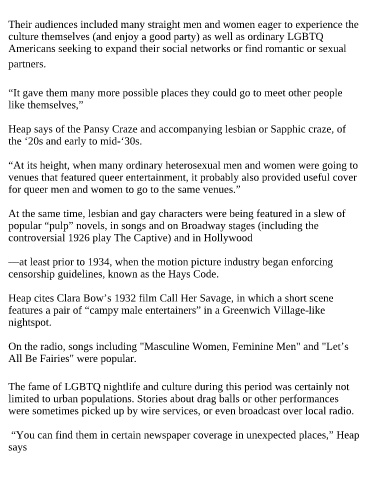Page 458 - ILIAS ATHANASIADIS AKA RO1
P. 458
Their audiences included many straight men and women eager to experience the
culture themselves (and enjoy a good party) as well as ordinary LGBTQ
Americans seeking to expand their social networks or find romantic or sexual
partners.
“It gave them many more possible places they could go to meet other people
like themselves,”
Heap says of the Pansy Craze and accompanying lesbian or Sapphic craze, of
the ‘20s and early to mid-‘30s.
“At its height, when many ordinary heterosexual men and women were going to
venues that featured queer entertainment, it probably also provided useful cover
for queer men and women to go to the same venues.”
At the same time, lesbian and gay characters were being featured in a slew of
popular “pulp” novels, in songs and on Broadway stages (including the
controversial 1926 play The Captive) and in Hollywood
—at least prior to 1934, when the motion picture industry began enforcing
censorship guidelines, known as the Hays Code.
Heap cites Clara Bow’s 1932 film Call Her Savage, in which a short scene
features a pair of “campy male entertainers” in a Greenwich Village-like
nightspot.
On the radio, songs including "Masculine Women, Feminine Men" and "Let’s
All Be Fairies" were popular.
The fame of LGBTQ nightlife and culture during this period was certainly not
limited to urban populations. Stories about drag balls or other performances
were sometimes picked up by wire services, or even broadcast over local radio.
“You can find them in certain newspaper coverage in unexpected places,” Heap
says

